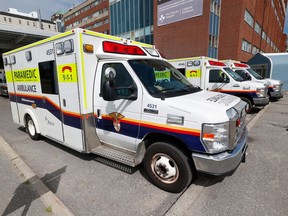The city announced the program last October as a way of easing the burden on paramedics and reducing the number of “Level Zeros” when no ambulances are available for a call.

Article content
The City of Ottawa’s plan to transport low-risk patients by taxi has been given a red light by the province.
Ottawa Paramedic Service Chief Pierre Poirier gave the bad news to the mayor and city councillors in a memo Monday afternoon that the city’s Safe Alternative Transportation Program had been rejected.
Article content
“The Ottawa Paramedic Service has now received confirmation that the Ministry of Health has denied the request to permit a paramedic to offer a taxi service to a patient,” Poirier said. “Specifically, they did not approve the use of 9-1-1 paramedics to coordinate alternate transportation options to the emergency department/hospital, including taxi services.”
Advertisement 2
Article content
The city announced the program last October as a way of easing the burden on paramedics and reducing the number of “Level Zeros” when no ambulances are available for a call.
Under the plan, 911 dispatchers would send an ambulance to the call where paramedics on the scene would check the patient and assess their needs and the level of care required. If the acuity was low, the paramedics would then contact a doctor for a second opinion. If the case was urgent, the patient would be taken to hospital by ambulance. If it wasn’t, the paramedics could cancel the call or send the patient by taxi to an alternate destination “better suited to meet their individual and immediate health care needs, such as a family physician or a specialty clinic.”
A low-acuity case could be a patient with a twisted ankle, or someone who needs stitches or is suffering from a urinary tract infection and is not in immediate danger. If the patient still insisted they wanted to go to the emergency department, paramedics could send them by taxi rather than ambulance.
About 20 per cent of the 250 ambulance calls in a typical day are considered low-acuity cases.
Advertisement 3
Article content
The Safe Alternative Transportation Program was to operate in conjunction with the city’s Mental Health Wellbeing Response Team and its Smart Transportation Program. The city had hoped to have the taxi service up and running by Nov. 1, but the wait for approval from the province has dragged on ever since.
“I can confirm that staff continue to explore other options, including the use of community paramedics, to provide care and appropriate transportation (including the use of a taxi) of patients to the hospital,” Poirier said, promising to provide more information as it becomes available.
The Save Alternative Transport Plan was one way the paramedic service was trying to reduce the burden on ambulances. In 90 per cent of ambulance calls, paramedics are kept waiting at the hospital for 2.5 hours or longer, tending to patients until hospital staff can assume care. The underlying cause could be a shortage of nurses or open hospital beds, or the emergency department could just be busier than normal, but regardless of the reason, delays mean ambulances are off the road and unable to respond to calls.
In 2022, the Ottawa Paramedic Service was at Level Zero 1,313 times for a total of 53,885 minutes.
Our website is your destination for up-to-the-minute news, so make sure to bookmark our homepage and sign up for our newsletters so we can keep you informed.
Recommended from Editorial
Article content





